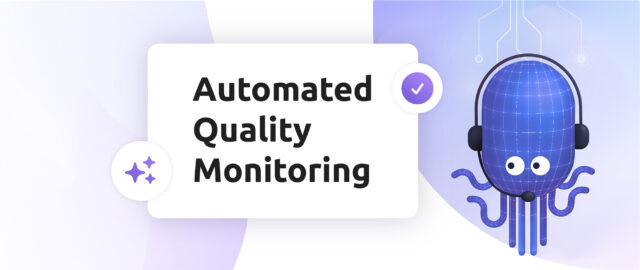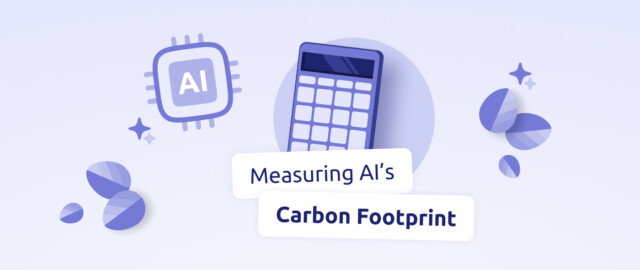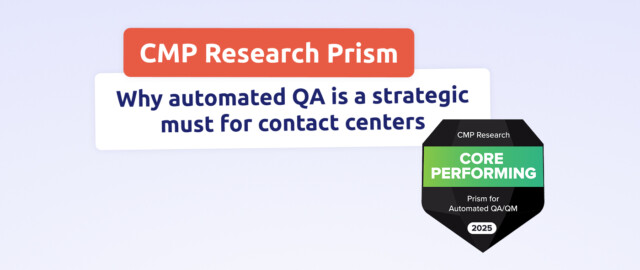What is Automated Quality Monitoring (AQM)?
Automated Quality Monitoring, or AQM, is an innovative approach to quality control in customer relations centers.
The principle is simple: use artificial intelligence and machine learning to automatically analyze interactions between agents and customers across all channels: calls, emails, Intelligent Virtual Agent…
AQM automatically analyzes 100% of customer exchanges
The aim of Automated Quality Monitoring is to continuously assess the quality of service delivered and compliance with processes, and ultimately to identify areas for improvement.
Unlike traditional manual quality monitoring, where supervisors listen to a selected sample of calls, AQM allows you to review all customer exchanges.
In concrete terms, Automated Quality Monitoring uses AI algorithms to transcribe and analyze each conversation, based on predefined criteria such as adherence to script, level of empathy or resolution of the customer problem. Each interaction is then assigned an objective and consistent quality score.
It’s this objective and exhaustive nature of AQM that changes the game. With Automated Quality Monitoring, almost 100% of exchanges are checked, far more than with the manual sampling approach.
AQM improves analysis quality
This quantitative leap is accompanied by a qualitative leap. AQM offers greater analytical finesse.
Where a supervisor may miss certain flaws, AQM tools detect problems both systematically and impartially: no quality defect escapes the AI’s attentive ear.
What’s the technology behind AQM? Answer: artificial intelligence. AQM is based on technologies such as automatic speech transcription, emotion recognition and semantic analysis. These technologies make it possible to “dissect” each interaction to extract key elements: the words and expressions used, the tone employed, moments of tension or satisfaction…
Automated Quality Monitoring is a powerful approach to auditing service quality, in a more exhaustive, objective and detailed way than traditional manual control. This enables contact centers to monitor and control team performance more closely, with a view to continuous improvement.
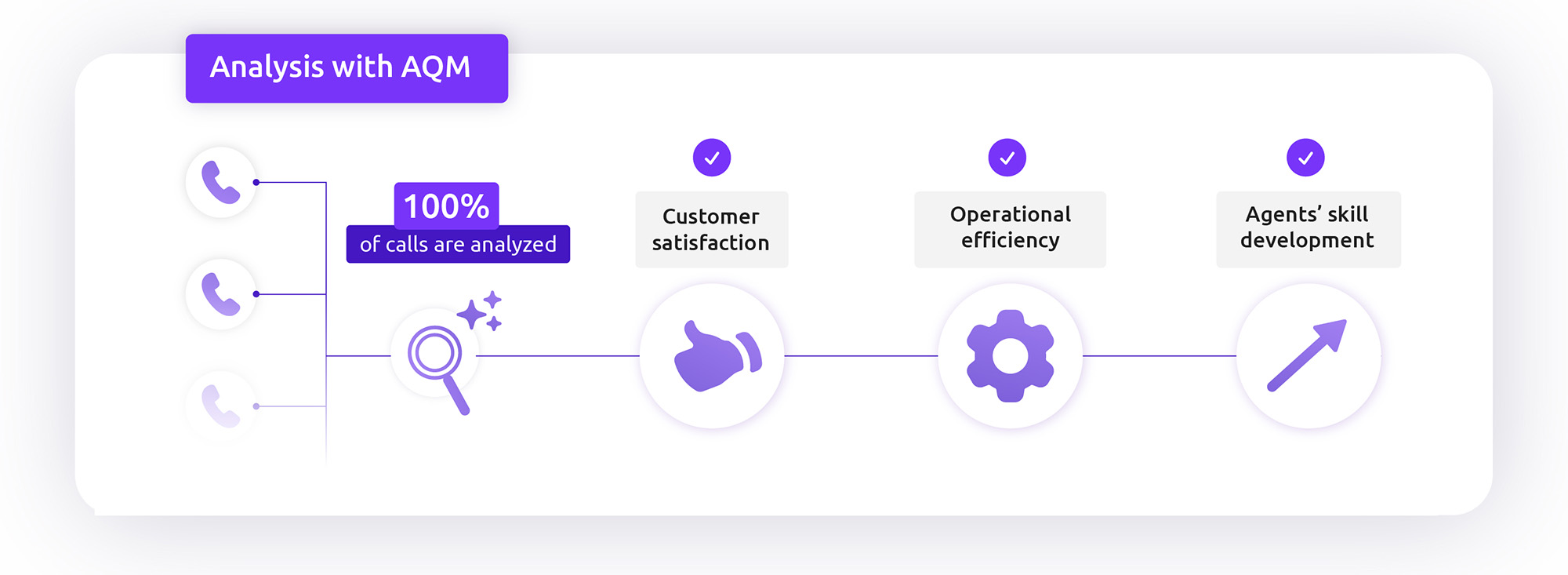
The benefits of Automated Quality Monitoring
Automated Quality Monitoring offers a number of tangible benefits to companies committed to excellence in customer relations. Here are the 6 main benefits of AQM.
Benefit no. 1: More complete and accurate analysis of customer interactions
With Automated Quality Monitoring, all customer exchanges are screened, not just a sample. The result? An exhaustive vision of service quality, with the possibility of zooming in on friction points or best practices.
Benefit no. 2: Objective assessment of agent performance
AQM eliminates the subjectivity inherent in manual spot checks. It eliminates human bias, thus complementing the work of supervisors.
AI rates each interaction according to consistent criteria to obtain 100% objective assessments. AQM enables a real change of approach to team management and HR decisions (promotions, bonuses, etc.).
Benefit no. 3: Free up time for managers and supervisors
The ability to automate time-consuming listening and assessment tasks saves managers and supervisors valuable time.
Thanks to AQM, they can make more informed decisions and concentrate on higher value-added activities:
- Trend analysis.
- Identification of training needs.
- Personalized agent coaching.
- Etc.
Benefit no. 4: Better compliance with standards and regulations
In highly regulated sectors such as banking and insurance, AQM greatly facilitates compliance audits and risk prevention.
AI can automatically check whether agents are delivering the required legal notices, following call scripts or respecting the confidentiality of customer data. When a breach occurs, it is automatically and immediately detected, enabling it to be corrected much more quickly.
Benefit no. 5: Lower costs and greater efficiency
For all the reasons given above, AQM reduces the cost and time required to assess customer service quality.
What’s more, AQM boosts quality and customer retention, which in turn boosts sales. In short, well-applied AQM saves the company time and money.
Benefit no. 6: Improved overall customer experience
Ultimately, the big winner of AQM is the customer. With better-trained and coached agents, continuously optimized processes and upstream detection of irritants, everything is in place to improve the customer experience in a sustainable and effective way.
The benefits of Automated Quality Monitoring are therefore numerous. The next question on everyone’s lips: how do you implement AQM in a contact center? Let’s find out.
Are you looking to develop automation within your contact center? We recommend you read this complementary article: Improve contact center efficiency with workflow automation.
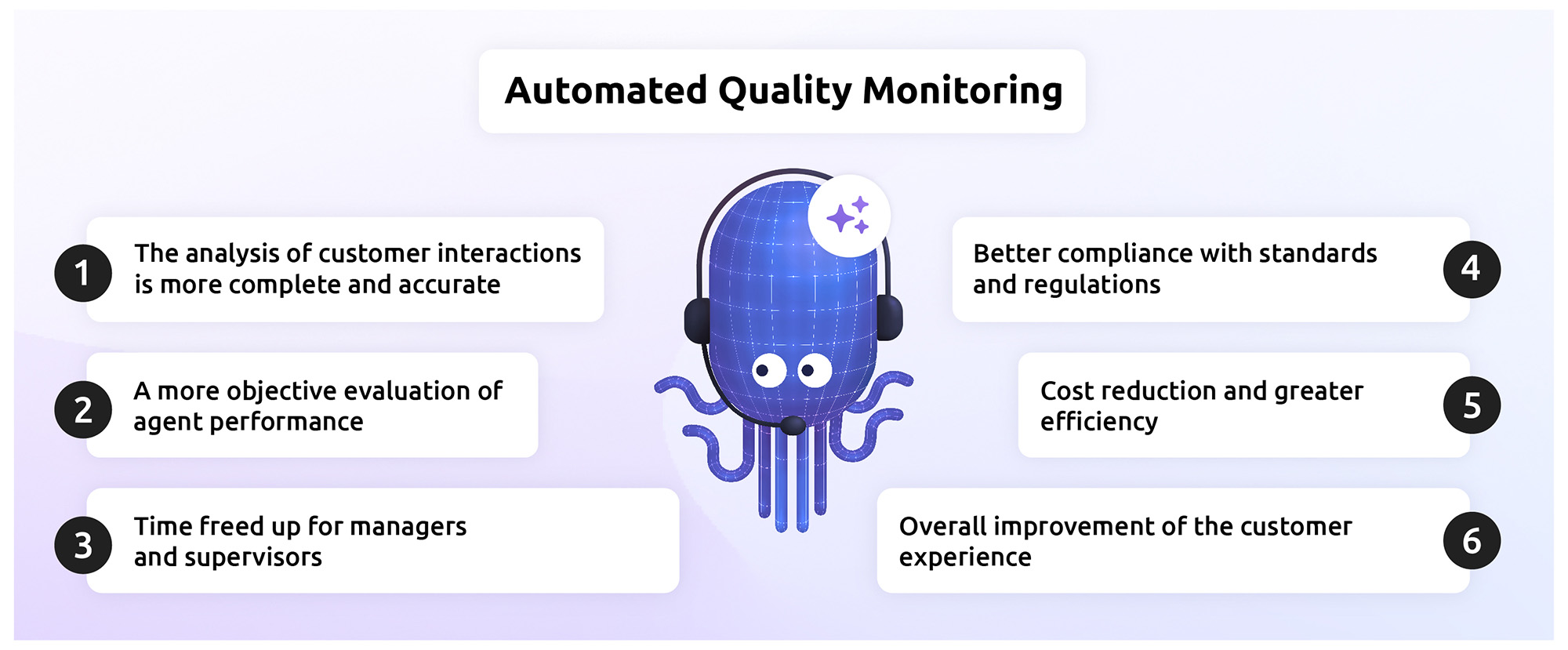
How do I set up Automated Quality Monitoring?
Setting up an Automated Quality Monitoring system requires a structured approach. Here are the key steps to effectively deploying AQM in your contact center.
Step 1: Define clear objectives and measurable quality criteria
It all starts with a clear vision of what you want to achieve with AQM. That’s always the place to start. You have to answer this simple question: “What are your priority objectives?”
Improve customer satisfaction? Strengthen regulatory compliance? Reduce processing times?
We recommend that you formalize these objectives and choose associated KPIs to be able to assess your level of success.
This is also the time to define your quality criteria:
- What are successful interactions?
- What kind of behavior do you expect from your agents?
Be specific: response time, personalization, first contact resolution… These criteria will be the compass of your AQM system. Don’t hesitate to consult customer relationship center experts, such as Diabolocom, to identify areas for improvement and relevant use cases for integrating AI and AQM into your quality monitoring.
Step 2: Choose the right technology solution for your needs
Now it’s time to choose the AQM platform that will support you. The range is vast, but there are a few points to keep an eye on.
- Omnichannel. Opt for a solution capable of analyzing all your contact center’s communication channels: calls, emails, Intelligent Virtual Agent…
- Depth of analysis. Also check the finesse of the analysis criteria proposed. It’s important to have access to granular evaluation to precisely identify areas for improvement. Typically, solutions that offer automatic transcription or emotion and language analysis capabilities are a real plus.
- Simplicity & flexibility. Also consider the ease of use and flexibility of the solution. The system will only be effective if it works. To be effective, it must be easily accessible and usable by the people who drive AQM.
Diabolocom’s contact center management solution meets all these criteria. Find out more about our in-house Quality Monitoring solution.
Step 3: Train and involve the teams concerned
Your agents and supervisors are the first to be affected by AQM. It is therefore important to train them and include them in the process from the outset. You need to explain the objectives and expected benefits of AQM, and share the new quality criteria and process changes with them.
AQM offers many benefits for your teams:
- Objective assessment of customer interactions.
- Identifying areas for improvement and highlighting acquired skills.
- Personalized agent training and the possibility of targeted coaching.
The aim of AQM is not control, but continuous improvement.
At Diabolocom, for example, individual dashboards enable each agent to track his or her progress, with a view to encouraging a culture of continuous improvement and skills enhancement.
Step 4: Implement monitoring and continuous improvement processes
To get the best out of AQM, analysis alone is not enough: you have to act on the results.
Two tips on this subject:
- Set up regular rituals for reviewing evaluations with your teams.
- Target 2-3 improvement priorities together and define concrete action plans: training, call script updates, process optimization…
With our Diabolocom solution, you can easily create customized reports to track the impact of your actions over time, so you can better manage your continuous improvement process.
Step 5: Use the insights generated by AQM to optimize the customer experience
The AQM is a gold mine for identifying irritants and customer expectations. Analyzing recurring reasons for dissatisfaction will help you adjust your service offering and processes accordingly.
Analysis is used to identify areas for improvement.
This is the promise of Automated Quality Monitoring: to proactively audit the quality of interactions on a large scale, so as to ultimately deliver a quality customer experience.
This challenge is within every company’s grasp, provided it has the right tools and involves its teams in a continuous improvement process.
Automated Quality Monitoring: best practices to follow
Finally, here are a few best practices for getting the most out of Automated Quality Monitoring.
Combining AQM with “human” spot assessments
While AI brings power and objectivity, human judgment remains essential to assess the most complex interactions. Some specific or sensitive cases will always require the analysis of a supervisor. Similarly, it would be unthinkable for HR decision-making to rely solely on AI.
We therefore recommend that you capitalize on the complementarity between AQM and ad hoc human assessments. This is what the Diabolocom solution offers, combining AI and human supervision for comprehensive, nuanced quality monitoring.

Customize evaluation criteria to suit your strategy
Every company has its own vision of service quality. Your AQM criteria must reflect YOUR priorities and quality standards. This ensures that monitoring is aligned with your strategy.
With Diabolocom, you’re free to define your own evaluation criteria. In just a few clicks, you can inform the AI of the KPIs most relevant to your business. You can even create customized grids by type of interaction, product or customer segment.
Use AQM across all channels
Your customer relations are not limited to telephone calls. Your customers also contact you by email, chat, Intelligent Virtual Agent or social networks. For a 360° view of your service quality, your AQM solution needs to cover ALL your contact channels. The aim is to ensure a consistent level of service across your entire relational ecosystem.
Diabolocom understands this imperative, and its technology can evaluate both voice and written interactions. Diabolocom is firmly positioned as an omnichannel platform, enabling it to manage interactions across all dialogue channels.
Transparent communication on the use of AQM
AQM involves the analysis of a large number of customer interactions.
It’s not just a question of trust, it’s also a question of image: communicate positively about your AQM approach, highlighting your commitment to continuous service improvement. You need to get this message across to your customers – they’ll be sure to applaud your commitment!
Ensure data confidentiality and security
Finally, data security is a major challenge for AQM.
Your platform must meet the highest standards of data protection:
- Exchange encryption: Ensure that all communications are encrypted to prevent unauthorized access to data.
- Fine-tuned access and authorization management: Control and limit access to sensitive data to authorized people only, according to their roles.
- Secure data hosting: host data on secure servers offering advanced protection against cyber-attacks and data breaches.
In addition, it’s essential to comply with regulations such as the RGPD: make sure that all data subjects are informed about registration practices and that they have given their explicit consent before starting any registration.
Conclusion
Automated Quality Monitoring is gradually establishing itself as the new standard for quality control in contact centers. This technology, made possible by advances in AI, enables companies to gain in responsiveness, efficiency and customer satisfaction.
However, the success of your AQM project depends on choosing a solution tailored to your business challenges and following best practices, as we have seen. This is the prerequisite for making Automated Quality Monitoring a real competitive advantage in the service of relational excellence.
So, whether you’re an SME or a major corporation, if you’re committed to delivering an exceptional customer experience, it’s probably time to take a close look at AQM.
Curious to know more about Diabolocom?
